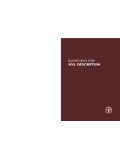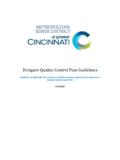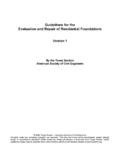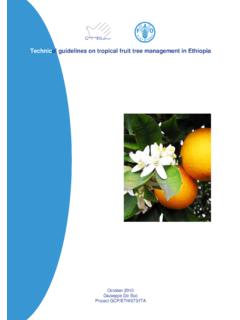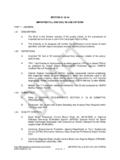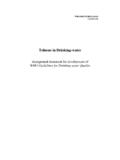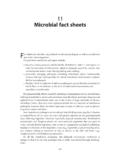Transcription of GUIDELINES FOR FILTER MEDIA IN BIOFILTRATION ... - Graie
1 GUIDELINES FOR FILTER MEDIA IN BIOFILTRATION SYSTEMS (Version ). June 2009. The following GUIDELINES for FILTER MEDIA in BIOFILTRATION systems have been prepared on behalf of the Facility for Advancing Water BIOFILTRATION (FAWB) to assist in the development of BIOFILTRATION systems, including the planning, design, construction and operation of those systems. NOTE: This is a revision of the previous FAWB guideline specifications (published in 2006 (Version ), 2008 (Version )). It attempts to provide a simpler and more robust guideline for both soil- based and engineered FILTER MEDIA . FAWB acknowledges the contribution of EDAW Inc., Melbourne Water Corporation, Dr Nicholas Somes (Ecodynamics), Alan Hoban (South East Queensland Healthy Waterways Partnership), Shaun Leinster (DesignFlow) and STORM Consulting to the preparation of the revised GUIDELINES . Disclaimer The GUIDELINES for Soil FILTER MEDIA in BIOFILTRATION Systems are made available and distributed solely on an "as is" basis without express or implied warranty.
2 The entire risk as to the quality, adaptability and performance is assumed by the user. It is the responsibility of the user to make an assessment of the suitability of the GUIDELINES for its own purposes and the GUIDELINES are supplied on the understanding that the user will not hold EDAW Inc., Monash University, or parties to the Facility for Advancing Water BIOFILTRATION (FAWB). ( the Licensor ) liable for any loss or damage resulting from their use. To the extent permitted by the laws of Australia, the Licensor disclaims all warranties with regard to this information, including all implied warranties of merchantability and fitness. In no event shall the Licensor be liable for any special, direct or consequential damages or any damages whatsoever resulting from loss or use, whether in action of contract, negligence or other tortious action, arising out of the use of, or performance of this information.
3 1 GENERAL DESCRIPTION. The BIOFILTRATION FILTER MEDIA GUIDELINES require three layers of MEDIA : the FILTER MEDIA itself (400-600 mm deep or as specified in the engineering design), a transition layer (100 mm deep), and a drainage layer (50 mm minimum cover over underdrainage pipe). The BIOFILTRATION system will operate so that water will infiltrate into the FILTER MEDIA and move vertically down through the profile. The FILTER MEDIA is required to support a range of vegetation types (from groundcovers to trees) that are adapted to freely draining soils with occasional wetting. The material should be based on natural or amended natural soils or it can be entirely engineered; in either case, it can be of siliceous or calcareous origin. In general, the MEDIA should have an appropriately high permeability under compaction and should be free of rubbish, deleterious material, toxicants, declared plants and local weeds (as listed in local GUIDELINES /Acts), and should not be hydrophobic.
4 The FILTER MEDIA should contain some organic matter for increased water holding capacity but be low in nutrient content. In the case of natural or amended natural soils, the MEDIA should be a loamy sand. BIOFILTRATION FILTER MEDIA GUIDELINES (Version ), Prepared by the Facility for Advancing Water BIOFILTRATION (FAWB), June 2009. Maintaining an adequate infiltration capacity is crucial in ensuring the long-term treatment efficiency of the system. The ability of a BIOFILTRATION system to detain and infiltrate incoming stormwater is a function of the FILTER surface area, extended detention (ponding) depth, and the hydraulic conductivity of the FILTER MEDIA (Figure 1). Most importantly, design of a BIOFILTRATION system should optimize the combination of these three design elements. For a BIOFILTRATION system in a temperate climate with an extended detention depth of 100 300 mm and whose surface area is approximately 2% of the connected impervious area of the contributing catchment, the prescribed hydraulic conductivity will generally be between 100 300 mm/hr in order to meet best practice targets (Figure 2).
5 This configuration supports plant growth without requiring too much land space. In warm, humid (sub- and dry- tropical) regions the hydraulic conductivity may need to be higher in order to achieve the required treatment performance using the same land space ( , ensuring that the proportion of water treated through the MEDIA meets requirements). Where one of these design elements falls outside the recommended range, the infiltration capacity can still be maintained by offsetting another of the design elements. For example, a FILTER MEDIA with a lower hydraulic conductivity may be used, but the surface area or the extended detention depth would need to be increased in order to maintain the treatment capacity. Similarly, if the available land were the limiting design element, the system could still treat the same size storm if a FILTER MEDIA with a higher hydraulic conductivity were installed.
6 Where a hydraulic conductivity greater than 300 mm/hr is prescribed, potential issues such as higher watering requirements during the establishment should be considered. BIOFILTRATION systems with a hydraulic conductivity greater than 600 mm/hr are unlikely to support plant growth due to poor water retention, and may also result in leaching of pollutants. However plant survival might be possible if the outlet pipe were raised to create a permanently submerged zone. FILTER MEDIA hydraulic conductivity conductivity infiltration extended capacity FILTER detention surface depth area Figure 1. Design elements that influence infiltration capacity. BIOFILTRATION FILTER MEDIA GUIDELINES (Version ), Prepared by the Facility for Advancing Water BIOFILTRATION (FAWB), June 2009. Figure 2. Recommended FILTER MEDIA hydraulic conductivity range and potential issues The infiltration capacity of the BIOFILTRATION system will initially decline during the establishment phase as the FILTER MEDIA settles and compacts, but this will level out and then start to increase as the plant community establishes itself and the rooting depth increases (see Appendix A).
7 In order to ensure that the system functions adequately at its eventual (minimum) hydraulic conductivity, a safety co-efficient of 2 should be used: , designs should be modelled using half the prescribed hydraulic conductivity. If a system does not perform adequately with this hydraulic conductivity, then the area and/or ponding depth should be increased. It may also be desirable to report sensitivity to infiltration rate, rather than simply having expected rate. This is important when assessing compliance of constructed systems as systems should ideally meet best practice across a range of infiltration rates. 2 TESTING REQUIREMENTS. Determination of Hydraulic Conductivity The hydraulic conductivity of potential FILTER MEDIA should be measured using the ASTM F1815-06. method. This test method uses a compaction method that best represents field conditions and so provides a more realistic assessment of hydraulic conductivity than other test methods.
8 Note: if a hydraulic conductivity lower than 100 mm/hr is prescribed, the level of compaction associated with this test method may be too severe and so underestimate the actual hydraulic conductivity of the FILTER MEDIA under field conditions. However, FAWB considers this to be an appropriately conservative test, and recommends its use even for low conductivity MEDIA . Particle Size Distribution Particle size distribution (PSD) is of secondary importance compared with hydraulic conductivity. A. material whose PSD falls within the following recommended range does not preclude the need for hydraulic conductivity testing , it does not guarantee that the material will have a suitable hydraulic conductivity. However, the following composition range (percentage w/w) provides a useful guide for selecting an appropriate material: BIOFILTRATION FILTER MEDIA GUIDELINES (Version ), Prepared by the Facility for Advancing Water BIOFILTRATION (FAWB), June 2009.
9 Clay & Silt <3% (< mm). Very Fine Sand 5-30% ( mm). Fine Sand 10-30% ( mm). Medium to Coarse Sand 40-60% ( mm). Coarse Sand 7-10% ( mm). Fine Gravel <3% ( mm). Clay and silt are important for water retention and sorption of dissolved pollutants, however they substantially reduce the hydraulic conductivity of the FILTER MEDIA . This size fraction also influences the structural stability of the material (through migration of particles to block small pores and/or slump). It is essential that the total clay and silt mix is less than 3% (w/w) to reduce the likelihood of structural collapse of such soils. The FILTER MEDIA should be well-graded , it should have all particle size ranges present from the mm to the mm sieve (as defined by - 1995). There should be no gap in the particle size grading, and the composition should not be dominated by a small particle size range. This is important for preventing structural collapse due to particle migration.
10 Soil-Based FILTER MEDIA : Properties The following specifications are based on results of extensive treatment performance testing conducted by FAWB as well as recommendations made by AS4419 2003 (Soils for Landscaping and Garden Use). FILTER MEDIA must be tested for the following; MEDIA that do not meet these specifications should be rejected or amended: i. Total Nitrogen (TN) Content <1000 mg/kg. ii. Orthophosphate (PO43-) Content <80 mg/kg. Soils with total phosphorus concentrations >100 mg/kg should be tested for potential leaching. Where plants with moderate phosphorus sensitivity are to be used, total phosphorus concentrations should be <20. mg/kg. iii. Organic Matter Content at least 3% (w/w). An organic content lower than 3% is likely to have too low a water holding capacity to support healthy plant growth. In order to comply with both this and the TN and PO43- content requirements, a low nutrient organic matter will be required.

